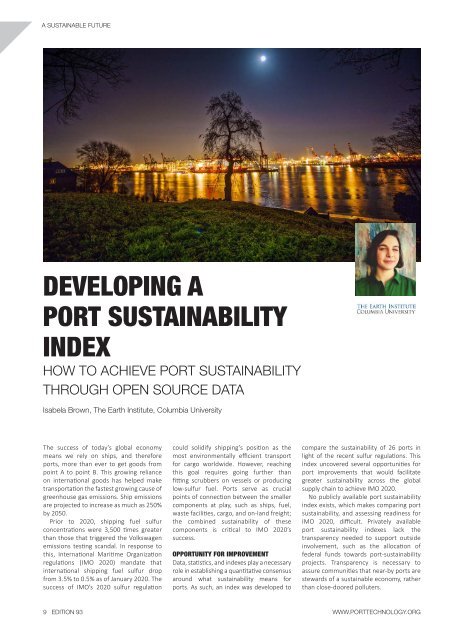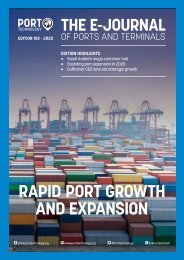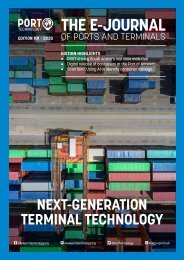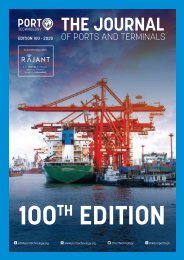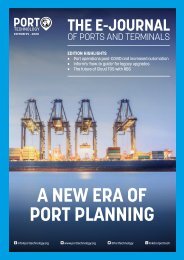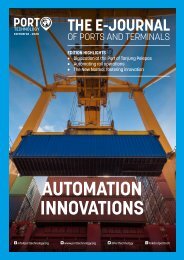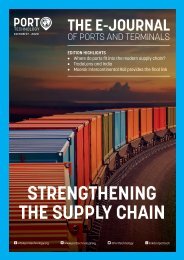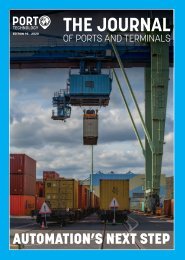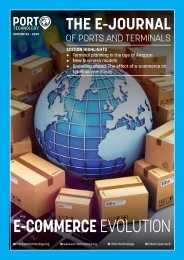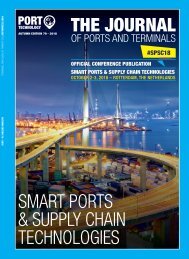A Sustainable Future
Port Technology International’s first e-Journal of 2020 explores the topic of sustainability in ports. Climate change is set to be a defining topic for the 2020s as awareness of its real-time impact is increasing.
Port Technology International’s first e-Journal of 2020 explores the topic of sustainability in ports. Climate change is set to be a defining topic for the 2020s as awareness of its real-time impact is increasing.
You also want an ePaper? Increase the reach of your titles
YUMPU automatically turns print PDFs into web optimized ePapers that Google loves.
A SUSTAINABLE FUTURE<br />
DEVELOPING A<br />
PORT SUSTAINABILITY<br />
INDEX<br />
HOW TO ACHIEVE PORT SUSTAINABILITY<br />
THROUGH OPEN SOURCE DATA<br />
Isabela Brown, The Earth Institute, Columbia University<br />
The success of today’ s global economy<br />
means we rely on ships, and therefore<br />
ports, more than ever to get goods from<br />
point A to point B. This growing reliance<br />
on international goods has helped make<br />
transportation the fastest growing cause of<br />
greenhouse gas emissions. S hip emissions<br />
are projected to increase as much as 250%<br />
by 2050.<br />
Prior to 2020, shipping fuel sulfur<br />
concentrations were 3,500 times greater<br />
than those that triggered the Volkswagen<br />
emissions testing scandal. In response to<br />
this, International Maritime Organization<br />
regulations (IMO 2020) mandate that<br />
international shipping fuel sulfur drop<br />
from 3.5% to 0.5% as of January 2020. The<br />
success of IMO’s 2020 sulfur regulation<br />
could solidify shipping’s position as the<br />
most environmentally efficient transport<br />
for cargo worldwide. However, reaching<br />
this goal requires going further than<br />
fing scrubbers on vessels or producing<br />
low-sulfur fuel. Ports serve as crucial<br />
points of connection between the smaller<br />
components at play, such as ships, fuel,<br />
waste facilities, cargo, and on-land freight;<br />
the combined sustainability of these<br />
components is critical to IMO 2020’s<br />
success.<br />
OPPORTUNITY FOR IMPROVEMENT<br />
Data, statistics, and indexes play a necessary<br />
role in establishing a quantitative consensus<br />
around what sustainability means for<br />
ports. As such, an index was developed to<br />
compare the sustainability of 26 ports in<br />
light of the recent sulfur regulations. This<br />
index uncovered several opportunities for<br />
port improvements that would facilitate<br />
greater sustainability across the global<br />
supply chain to achieve IMO 2020.<br />
No publicly available port sustainability<br />
index exists, which makes comparing port<br />
sustainability, and assessing readiness for<br />
IMO 2020, difficult. Privately available<br />
port sustainability indexes lack the<br />
transparency needed to support outside<br />
involvement, such as the allocation of<br />
federal funds towards port-sustainability<br />
projects. Transparency is necessary to<br />
assure communities that near-by ports are<br />
stewards of a sustainable economy, rather<br />
than close-doored polluters.<br />
9 EDITION 93<br />
WWW.PORTTECHNOLOGY.ORG


